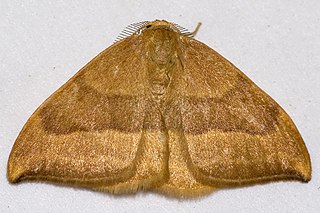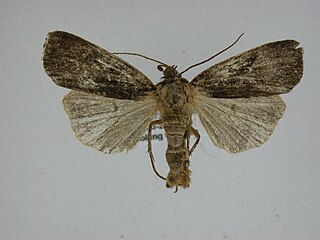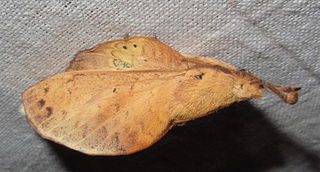
Betula populifolia is a deciduous tree native to eastern North America.

Nepticulidae is a family of very small moths with a worldwide distribution. They are characterised by eyecaps over the eyes. These pigmy moths or midget moths, as they are commonly known, include the smallest of all living moths, with a wingspan that can be as little as 3 mm in the case of the European pigmy sorrel moth, but more usually 3.5–10 mm. The wings of adult moths are narrow and lanceolate, sometimes with metallic markings, and with the venation very simplified compared to most other moths.

Macrothylacia rubi, the fox moth, is a lepidopteran belonging to the family Lasiocampidae. It was first described by Carl Linnaeus in his 1758 10th edition of Systema Naturae.

Drepana cultraria, the barred hook-tip, is a moth of the family Drepanidae and part of Drepana subgenus Watsonalla. It is found in southern and central Europe.

Gastropacha quercifolia, the lappet, is a moth of the family Lasiocampidae. It is found in Europe and east across the Palearctic to Japan.

Drepana curvatula, the dusky hook-tip, is a moth of the family Drepanidae. It was first described by Moritz Balthasar Borkhausen in 1790 and it is found from Europe to Japan.

Cymatophorina is a monotypic moth genus of the family Drepanidae first described by Arnold Spuler in 1908. Its only species, Cymatophorina diluta, the oak lutestring or lesser lutestring, was described by Michael Denis and Ignaz Schiffermüller in 1775. It is found in much of Europe, with subspecies Cymatophorina diluta hartwiegi occurring in Britain.

Pseudothyatira is a monotypic moth genus of the family Drepanidae first described by Augustus Radcliffe Grote in 1864. Its only species, Pseudothyatira cymatophoroides, the tufted thyatirid moth, was first described by Achille Guenée in 1852. It is found in North America in Newfoundland, British Columbia, northern California, Maryland, West Virginia, Kansas and North Carolina.

Estigena is a genus of moths in the family Lasiocampidae. It was erected by Frederic Moore in 1860. It is found throughout India, Sri Lanka, the Middle East, Myanmar and Java.

Gastropacha is a genus of moths in the family Lasiocampidae. It was first described by Ochsenheimer in 1810.

Lemonia dumi is a species of moth of the family Brahmaeidae. It is found in scattered populations in Central Europe.

Lemonia taraxaci, the autumn silkworm moth, is a species of moth of the family Brahmaeidae. It was first described by Michael Denis and Ignaz Schiffermüller in 1775 and it is found in south-eastern Europe.

Pseudohermonassa bicarnea, the pink-spotted dart, is a moth of the family Noctuidae. The species was first described by Achille Guenée in 1852. It is found in eastern North America, and as far west as south-central Saskatchewan and central North Dakota, south to western North Carolina. It has recently been recorded from Tennessee.

Cameraria betulivora is a moth of the family Gracillariidae. It is known from Ontario and Quebec in Canada and the United States.

Gastropacha sikkima is a moth in the family Lasiocampidae. It is found in India, northern Thailand, Laos and Taiwan.

Archips purpuranus, the omnivorous leafroller moth, is a species of moth of the family Tortricidae. It is found in most of eastern North America.

Argyrotaenia mariana, the gray-banded leafroller moth, is a species of moth of the family Tortricidae. It is found in North America, where it has been recorded from Connecticut, Florida, Georgia, Illinois, Indiana, Kentucky, Maine, Maryland, Massachusetts, New Brunswick, New Hampshire, New York, North Carolina, Ohio, Ontario, Pennsylvania, Quebec, Tennessee and West Virginia.
Filatima betulae is a moth of the family Gelechiidae. It is found in North America, where it has been recorded from Massachusetts.

Gastropacha pardale, the brown lapped moth, is a moth of the family Lasiocampidae. The species was first described by Francis Walker in 1855.




















